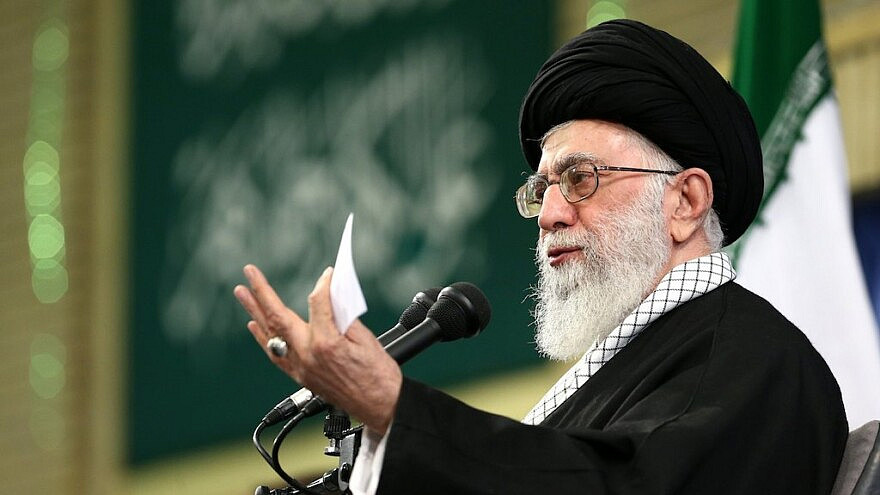 Khamenei threatens Israel, US with ‘crushing response’
Khamenei threatens Israel, US with ‘crushing response’
Update Desk | Israel at War
The Biden administration reportedly warned Tehran it would not be able to restrain Jerusalem in the event of another attack.
.
 Iranian Supreme Leader Ali Khamenei, Feb. 6, 2016. Source: Wikimedia Commons.
Iranian Supreme Leader Ali Khamenei, Feb. 6, 2016. Source: Wikimedia Commons.
Iran’s Supreme Leader Ali Khamenei stepped up his bellicose rhetoric on Saturday, threatening both Israel and the United States.
“The United States of America and the Zionist regime will definitely receive a crushing response for what they do against Iran and the Resistance Front,” the ayatollah tweeted.
An hour earlier, Khamenei had tweeted: “We will definitely do everything necessary to prepare the Iranian nation for confronting the Arrogant Powers, whether militarily, in terms of armament, or politically. Our officials are already working on this.”
Although he did not specify when and how Tehran was intending to act, the threat comes on the backdrop of a New York Times report suggesting that Khamenei recently instructed the country’s Supreme National Security Council to prepare for another assault on Israel.
Such an attack would be Iran’s third on the Jewish state, after ballistic missile assaults in April and October.
The U.S. has warned Tehran that it would not be able to restrain Jerusalem in the event of another attack, Axios reported on Saturday, citing an American and a former Israeli official.
“We told the Iranians: We won’t be able to hold Israel back, and we won’t be able to make sure that the next attack will be [as] calibrated and targeted as the previous one,” the U.S. official was quoted as saying.
In retaliation for the latest Iranian ballistic missile attack, on Oct. 26 dozens of Israeli aircraft, including refuelers and spy planes, struck targets across Iran in several waves over the course of a few hours. The targets reportedly included missile and drone manufacturing facilities and launch sites, as well as air-defense batteries, but not Iran’s nuclear program or energy infrastructure.
On Friday, Khamenei adviser Kamal Kharrazi told the Hezbollah-affiliated Al-Mayadeen outlet that the Islamic Republic would respond to Israel’s aerial attack at the appropriate time and manner.
According to the Times, Khamenei made that decision after reviewing a report from senior military commanders on the extent of the damage caused by the Israeli strikes.
Khamenei was said to have told his associates that the scope of Israel’s unprecedented Oct. 26 retaliatory strikes was “too large to ignore.”
The sources said that military commanders were readying a list of dozens of targets inside the Jewish state, but that the attack would likely occur after the U.S. presidential election on Nov. 5 due to concern in Tehran that additional tensions in the region could boost Republican presidential nominee and former president Donald Trump.
US deploys B-52 bombers to Middle East
U.S. Central Command (CENTCOM) announced on Saturday that B-52 bombers had arrived in the Middle East amid the Iranian threats against Israel and the United States.
“B-52 Stratofortress strategic bombers from Minot Air Force Base’s 5th Bomb Wing arrived in the U.S. Central Command area of responsibility,” CENTCOM tweeted, with an accompanying picture of one of the massive planes on final approach.
Defense Secretary Lloyd Austin announced the deployment of the bomber aircraft on Friday, along with U.S. Navy warships.
The Associated Press, citing four U.S. and defense officials, reported on Friday that Austin ordered several B-52 Stratofortress bomber aircraft, tanker aircraft and Navy destroyers to the Middle East.
The U.S. did not provide specific numbers of planes and ships sent to the region.
A U.S. official told AP that Austin ordered the deployment of the destroyers, capable of shooting down ballistic missiles, to replace the USS Abraham Lincoln aircraft carrier and its strike group of three Naval destroyers, which are scheduled to depart the Mideast in mid-November for their home port of San Diego.
The Lincoln and two of its destroyers are stationed in the Gulf of Oman, and the third destroyer is with two other warships in the Red Sea.
Eventually, the USS Harry S. Truman aircraft carrier and its three warships will move to the Mediterranean Sea, but not before the Lincoln departs, thus the three destroyers will fill in the gap.
Jerusalem warns Baghdad it may attack Iraqi militias
Jerusalem has warned Baghdad that unless it reins in Iranian-backed militias launching drones and missiles at Israel, it could attack Iraq, according to a report in the Saudi website Elaph.
According to the report, Israel has identified and is monitoring targets belonging to the Iranian-backed militias and also Iraqi state targets and could start attacking them if the militias keep firing at the Jewish state.
Unnamed officials told Elaph that satellites are monitoring the movement of ballistic missiles and related equipment from Iran to Iraq, which could be used in an attack on Israel.
Iraqi sources expressed concern to the outlet that Tehran could be using Iraq to shift the fighting away from its territory.
The AP reported last week that Israel is under daily drone attack from Iraq, which the U.S. and its partners have had to intercept.
According to the report, the UAV launches have been a problem since the Hamas massacre of Oct. 7, 2023, and are not related to any Iranian attack. However, a regional security official said that the drone attacks have increased in recent weeks, with an average of five a day and eight drones launched over a 24-hour period in the past week.
The Islamic Resistance in Iraq is an umbrella organization composed of several Iranian-backed Shi’ite militias, including Kata’ib Hezbollah, Harakat Hezbollah al-Nujaba and Kata’ib Sayyid al-Shuhadaa. These groups operate both in Iraq and Syria under IRGC command.
Regime supporters mark 1979 hostage crisis
Supporters of the Iranian regime gathered outside the former U.S. embassy in Tehran on Sunday to mark the anniversary of the 1979 hostage crisis with shouts of “Death to Israel, Death to America!”
The former embassy is currently a museum called the “Den of Spies” and is covered with anti-American murals.
The crowd also set Israeli and American flags on fire in the annual tradition.
IRGC chief Maj. Gen. Hossein Salami, in a speech at the Tehran rally, said that Israel and the U.S. “cannot survive by slaughtering and killing Muslims.
“We always warn them that if they don’t change their behavior, they will go toward collapse and destruction,” Salami said.
Iranians took over the U.S. embassy in Iran on Nov. 4, 1979, and kept 52 American diplomats and citizens hostage for 444 days. The hostage crisis ended on Jan. 20, 1981, when Ronald Reagan was inaugurated as president of the United States. No hostages were killed. Washington severed ties with Tehran in 1980, halfway through the crisis, and they have been frozen ever since.
Zawartość publikowanych artykułów i materiałów nie reprezentuje poglądów ani opinii Reunion’68,
ani też webmastera Blogu Reunion’68, chyba ze jest to wyraźnie zaznaczone.
Twoje uwagi, linki, własne artykuły lub wiadomości prześlij na adres:
webmaster@reunion68.com
